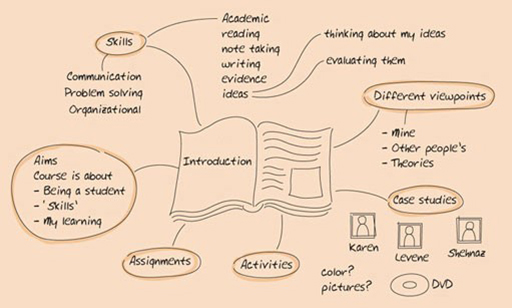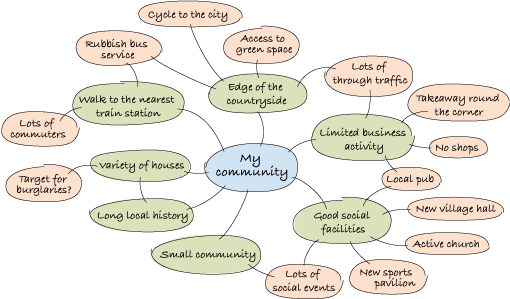1.2 Using mind maps to help make sense of complex information
One technique for making sense of complex information that many people find helpful is to draw a mind map that allows you to explore how all your different ideas could be connected.
Mind mapping was invented and developed by Tony Buzan, an author who has explored ways in which people think and learn. The technique helps open your mind to a broad range of ideas, and record these in a flexible format that can be easily altered and developed. So, as well as organising your thoughts and essay plans, mind mapping can help you to think more creatively and to come up with new ways of looking at things.
A mind map can be produced for any subject or topic. A good way of creating a mind map is to start with a large sheet of paper and coloured pens or pencils. Mind maps usually begin in the middle of the paper with a word, phrase, picture or symbol that represents the topic being explored.
The next stage is to let your mind wander as freely as possible around the topic. Think of some key words or phrases (there is no right or wrong here), then write them near to the central image or words. Finally, connect each of them to the centre with lines. This is the beginning of your mind map.
Keep adding lines and words (and pictures, if you like), linking them to each of the words or phrases that triggered them – so that your map becomes a network of words and lines.
Mind maps are often very personal – they are, after all, maps of your mind. They can be as elaborate or as simple as you wish – whatever you find helpful. Some people like to add a lot of detail, including colour, pictures, page references and examples, while others prefer a simple plan, concentrating on key points.
The figure below is a simple mind map that a student created for another course aimed at developing learning skills, reflecting on what they had learned.
Activity 2 Creating a mind map
Thinking about the community you live and/or work in, make a mind map to help you summarise ‘what makes my community distinctive’.
For this mind map, the central theme is ‘my community’, so put that in your central bubble, surrounded by five or six key things about the community which make it distinctive for you. These could be anything from its location (close to the city centre, countryside or water?); its history; some of its best/worst amenities (parks, sports or cultural facilities and regular social activities); the character and/or groupings of its inhabitants; the effectiveness/ineffectiveness of its public services; its political make-up. Draw lines from the central bubble outwards to the others, and add more bubbles and lines as you think of related things that you have learnt.
Discussion
Take a look at the mind map I drew of the community I live in.
Here I started by listing few distinctive features (in the green boxes), then moved on to think about some of the secondary consequences of those features (in the orange boxes) before I put in the linking lines. Remember that a mind map is a very personal piece of ‘sense-making’, so my neighbours or even members of my family might not produce anything similar, but the important thing is to highlight what makes it distinctive for you. Also note that its shape will change the more you think about different features and how they link together.


